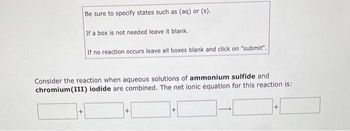
Chemistry
10th Edition
ISBN: 9781305957404
Author: Steven S. Zumdahl, Susan A. Zumdahl, Donald J. DeCoste
Publisher: Cengage Learning
expand_more
expand_more
format_list_bulleted
Concept explainers
Question
Qa 02.

Transcribed Image Text:Be sure to specify states such as (aq) or (s).
+
If a box is not needed leave it blank.
If no reaction occurs leave all boxes blank and click on "submit".
Consider the reaction when aqueous solutions of ammonium sulfide and
chromium(III) iodide are combined. The net ionic equation for this reaction is:
+
+
+
Expert Solution
This question has been solved!
Explore an expertly crafted, step-by-step solution for a thorough understanding of key concepts.
Step by stepSolved in 3 steps with 3 images

Knowledge Booster
Learn more about
Need a deep-dive on the concept behind this application? Look no further. Learn more about this topic, chemistry and related others by exploring similar questions and additional content below.Similar questions
- How do I solve for the percentage of error of the experiment? Data table: mass of empty 8'' test tube: 41.47 mass of test tube and metal: 91.59 the initial temperature of metal: 10.5 degrees Celcius mass of water in a cup: 75g the initial temperature of water: 24.7 degrees Celcius the final temperature of metal and water mix: 34.2 degrees celsius specific heat of water: 4.184 j/g degrees celsius specific heat of metal: 15.8 j/g celsiusarrow_forwardhow do you convert Joules to reciprocal cm (cm-1) ?arrow_forwardCalculate the kinetic energy of a 0.15kg baseball moving at a speed of 45.0ms. Round your answer to 2 significant digits.arrow_forward
- A student sets up the following equation to convert a measurement. (The ? stands for a number the student is going to calculate.) Fill in the missing part of this equation. Note: your answer should be in the form of one or more fractions multiplied together. (-1.7) =). 0 mmol. °C = ? kJ mol. °C x10 X 3 010 5arrow_forwardSelect all the expressions equal to (p.a) = (x c) Ор Op⋅a÷x.c pa q Op a÷ (x c) 1 C.C (p.a) x c IC □ (p.a). Op a I C p.a T I. Carrow_forwardHow many grams of N a CI would need to be added to 318.00 grams of water to lower the freezing point of water to minus 14.9 degrees C? Use 1.853 degrees C/m for Kf of water. Answer with the unit of grams. Your Answer:arrow_forward
- Calculate the amount of heat needed to boil 11.8 g of hexane (CH4), beginning from a temperature of 57.0 "C. Round your answer to 3 significant digits. Also, be sure your answer contains a unit symbol. 0 Xarrow_forwardIn Ray Bradbury’s 1953 novelFahrenheit 451, 451°F is said to be the temperature at which books,which have been banned in the story, ignite. Convert 451°F to theCelsius scale.arrow_forwardIn an experiment a group gathered the following data: Mass of test tube (g) 21.3Mass of test tube and metal (g) 52.7Mass of beaker (g) 120.40Mass of beaker and water (g) 137.54Initial temperature of hot metal (°C) 80.6Initial temperature of cold water (°C) 1.1Final temperature of the mixture (°C) 21.6 To the thousandths place, what is the specific heat of the metal used in the experiment above?arrow_forward
- Wine goes bad soon after opening because the ethanol (CH₂CH₂OH) in it reacts with oxygen gas (O₂) from the air to form water (H₂O) and acetic acid (CH₂COOH), the main ingredient of vinegar. What mass of ethanol is consumed by the reaction of 1.30 g of oxygen gas? Be sure your answer has the correct number of significant digits. X G sarrow_forwardWhat amount of heat, in J, is required to raise the temperature of 391.2 g of lead by 14.3°C? The specific heat of lead is 0.128 J/g°C. Give your answer in standard notation to 0 decimal places.arrow_forwardConvert 36 kcal to J Record the answer in scientific notation (e.g. 2.10E3J)arrow_forward
arrow_back_ios
SEE MORE QUESTIONS
arrow_forward_ios
Recommended textbooks for you
 ChemistryChemistryISBN:9781305957404Author:Steven S. Zumdahl, Susan A. Zumdahl, Donald J. DeCostePublisher:Cengage Learning
ChemistryChemistryISBN:9781305957404Author:Steven S. Zumdahl, Susan A. Zumdahl, Donald J. DeCostePublisher:Cengage Learning ChemistryChemistryISBN:9781259911156Author:Raymond Chang Dr., Jason Overby ProfessorPublisher:McGraw-Hill Education
ChemistryChemistryISBN:9781259911156Author:Raymond Chang Dr., Jason Overby ProfessorPublisher:McGraw-Hill Education Principles of Instrumental AnalysisChemistryISBN:9781305577213Author:Douglas A. Skoog, F. James Holler, Stanley R. CrouchPublisher:Cengage Learning
Principles of Instrumental AnalysisChemistryISBN:9781305577213Author:Douglas A. Skoog, F. James Holler, Stanley R. CrouchPublisher:Cengage Learning Organic ChemistryChemistryISBN:9780078021558Author:Janice Gorzynski Smith Dr.Publisher:McGraw-Hill Education
Organic ChemistryChemistryISBN:9780078021558Author:Janice Gorzynski Smith Dr.Publisher:McGraw-Hill Education Chemistry: Principles and ReactionsChemistryISBN:9781305079373Author:William L. Masterton, Cecile N. HurleyPublisher:Cengage Learning
Chemistry: Principles and ReactionsChemistryISBN:9781305079373Author:William L. Masterton, Cecile N. HurleyPublisher:Cengage Learning Elementary Principles of Chemical Processes, Bind...ChemistryISBN:9781118431221Author:Richard M. Felder, Ronald W. Rousseau, Lisa G. BullardPublisher:WILEY
Elementary Principles of Chemical Processes, Bind...ChemistryISBN:9781118431221Author:Richard M. Felder, Ronald W. Rousseau, Lisa G. BullardPublisher:WILEY

Chemistry
Chemistry
ISBN:9781305957404
Author:Steven S. Zumdahl, Susan A. Zumdahl, Donald J. DeCoste
Publisher:Cengage Learning

Chemistry
Chemistry
ISBN:9781259911156
Author:Raymond Chang Dr., Jason Overby Professor
Publisher:McGraw-Hill Education

Principles of Instrumental Analysis
Chemistry
ISBN:9781305577213
Author:Douglas A. Skoog, F. James Holler, Stanley R. Crouch
Publisher:Cengage Learning

Organic Chemistry
Chemistry
ISBN:9780078021558
Author:Janice Gorzynski Smith Dr.
Publisher:McGraw-Hill Education

Chemistry: Principles and Reactions
Chemistry
ISBN:9781305079373
Author:William L. Masterton, Cecile N. Hurley
Publisher:Cengage Learning

Elementary Principles of Chemical Processes, Bind...
Chemistry
ISBN:9781118431221
Author:Richard M. Felder, Ronald W. Rousseau, Lisa G. Bullard
Publisher:WILEY